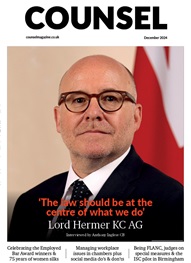*/
The Bar may have got better at recruiting women, but problems remain with their retention and treatment in the profession, according to two Bar Council reports.
In the first, Momentum Measures: Creating a diverse profession, the Bar Council said that a 50:50 balance of men and women entering the profession had been achieved and maintained since 2000.
But, due to issues that mean many women quit, it accepted that achieving a 50:50 split between men and woman practising barristers is “unlikely ever to be reached”.
Head of policy, equality, diversity and CSR, Sam Mercer, said: “The self-employed nature of the profession is a significant barrier to those who wish to have a family and stay in practice and legal aid cuts are making retention even more difficult.”
The second report, Snapshot: The experience of self-employed women at the Bar, painted a picture of sexism and harassment, with women objectified, discriminated against and pigeon-holed into doing family law or sexual offence cases because of their gender.
Among the litany of examples was that of a pupil who alleged that her supervisor told her she looked “quite fuckable” and said she ought to wear a jacket because he was “only human”.
One barrister said her senior clerk sold her to a solicitor on the basis that she had “a great pair of legs”.
While another said: ‘Too many men at the Bar feel that they are existing in a children’s playground, [they] think they can say grossly disrespectful things because nobody is going to stop them.”
Bar chair Alistair MacDonald QC said: “Whilst most of the experiences of sexism, harassment and discrimination quoted in the report are historical, experiences of inappropriate behaviour within the profession continue to exist.”
Although some women had “negative experiences and worked in a very challenging environment”, MacDonald said those who participated in the research “loved” the Bar. Others’ positive experiences, he said, challenge the view that the Bar is not women–friendly.
Meanwhile, the Lord Chief Justice, Lord Thomas, expressed disappointment that there had been “little marked improvement” in the percentage of judges from black and minority ethnic (BME)backgrounds, following publication of the 2015 Judicial Diversity Statistics.
The data showed that 159 of the 2,686 (5.9%) judges were from a BME background, up slightly from the 5.1% (154 out of 2,992) in 2011.
The Bar may have got better at recruiting women, but problems remain with their retention and treatment in the profession, according to two Bar Council reports.
In the first, Momentum Measures: Creating a diverse profession, the Bar Council said that a 50:50 balance of men and women entering the profession had been achieved and maintained since 2000.
But, due to issues that mean many women quit, it accepted that achieving a 50:50 split between men and woman practising barristers is “unlikely ever to be reached”.
Head of policy, equality, diversity and CSR, Sam Mercer, said: “The self-employed nature of the profession is a significant barrier to those who wish to have a family and stay in practice and legal aid cuts are making retention even more difficult.”
The second report, Snapshot: The experience of self-employed women at the Bar, painted a picture of sexism and harassment, with women objectified, discriminated against and pigeon-holed into doing family law or sexual offence cases because of their gender.
Among the litany of examples was that of a pupil who alleged that her supervisor told her she looked “quite fuckable” and said she ought to wear a jacket because he was “only human”.
One barrister said her senior clerk sold her to a solicitor on the basis that she had “a great pair of legs”.
While another said: ‘Too many men at the Bar feel that they are existing in a children’s playground, [they] think they can say grossly disrespectful things because nobody is going to stop them.”
Bar chair Alistair MacDonald QC said: “Whilst most of the experiences of sexism, harassment and discrimination quoted in the report are historical, experiences of inappropriate behaviour within the profession continue to exist.”
Although some women had “negative experiences and worked in a very challenging environment”, MacDonald said those who participated in the research “loved” the Bar. Others’ positive experiences, he said, challenge the view that the Bar is not women–friendly.
Meanwhile, the Lord Chief Justice, Lord Thomas, expressed disappointment that there had been “little marked improvement” in the percentage of judges from black and minority ethnic (BME)backgrounds, following publication of the 2015 Judicial Diversity Statistics.
The data showed that 159 of the 2,686 (5.9%) judges were from a BME background, up slightly from the 5.1% (154 out of 2,992) in 2011.


Chair of the Bar Sam Townend KC highlights some of the key achievements at the Bar Council this year
Louise Crush of Westgate Wealth Management highlights some of the ways you can cut your IHT bill
Rachel Davenport breaks down everything you need to know about AlphaBiolabs’ industry-leading laboratory testing services for legal matters
By Louise Crush of Westgate Wealth Management sets out the key steps to your dream property
A centre of excellence for youth justice, the Youth Justice Legal Centre provides specialist training, an advice line and a membership programme
By Kem Kemal of Henry Dannell
Mark Neale, Director General of the Bar Standards Board, offers an update on the Equality Rules consultation
Joanna Hardy-Susskind speaks to those walking away from the criminal Bar
Imposing a professional obligation to act in a way that advances equality, diversity and inclusion is the wrong way to achieve this ambition, says Nick Vineall KC
Tom Cosgrove KC looks at the government’s radical planning reform and the opportunities and challenges ahead for practitioners
By Ashley Friday of AlphaBiolabs